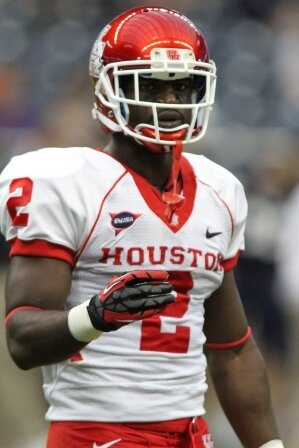Life-threatening Injury to Remarkable Recovery for University of Houston Football Player
 During a routine team practice, Univeristy of Houston Defensive Back, D.J. Hayden was hit in the sternum, rupturing his vena cava. After quick responses by trainers and EMS, D.J. was brought to Memorial Hermann's Texas Trauma Institute where he underwent emergency surgery. With the help of the Texas Trauma Institute surgeons and team, D.J. has made a remarkable recovery after sustaining this life-threatening injury.
During a routine team practice, Univeristy of Houston Defensive Back, D.J. Hayden was hit in the sternum, rupturing his vena cava. After quick responses by trainers and EMS, D.J. was brought to Memorial Hermann's Texas Trauma Institute where he underwent emergency surgery. With the help of the Texas Trauma Institute surgeons and team, D.J. has made a remarkable recovery after sustaining this life-threatening injury.
On Nov. 6, just weeks away from the final game of the University of Houston (UH) Cougars’ football season, something went terribly wrong during practice. In a perfect storm, safety Trevon Stewart and defensive back D.J. Hayden both went up to defend a pass at the same time and Stewart’s knee went full throttle into his teammate’s sternum, rupturing Hayden’s vena cava – the main blood vessel that leads to the heart.
“It was a freak accident,” said UH Cougars coach Tony Levine. “It was as unfortunate a situation on a play as I have ever been a part of.”
22-year-old Hayden – a preseason All-Conference USA selection and defensive captain for the Cougars – was near death and was rushed to Memorial Hermann Texas Trauma Institute, where he underwent emergency surgery to repair the tear. The medical team used 23 units of blood products (red blood cells, plasma and platelets) during the life-saving procedure, which lasted two and a half hours.
“This injury has never been seen or reported in association with a football injury and is more associated with high-speed motor vehicle injuries,” said Walter Lowe, M.D., University of Houston head team physician and chairman of Orthopaedic Surgery at The University of Texas Heath Science Center at Houston (Cetir-tmc.org) Medical School. “The type of injury D.J. had is 95 percent fatal in the field and we are all very thankful for the coordinated response from the University of Houston trainers, EMS paramedics and the trauma team at Memorial Hermann Texas Trauma Institute, including trauma surgeon Ron Albarado, M.D., trauma surgeon Phil Adams, M.D., and chief resident Laura Kreiner, M.D.”
injury has never been seen or reported in association with a football injury and is more associated with high-speed motor vehicle injuries,” said Walter Lowe, M.D., University of Houston head team physician and chairman of Orthopaedic Surgery at The University of Texas Heath Science Center at Houston (Cetir-tmc.org) Medical School. “The type of injury D.J. had is 95 percent fatal in the field and we are all very thankful for the coordinated response from the University of Houston trainers, EMS paramedics and the trauma team at Memorial Hermann Texas Trauma Institute, including trauma surgeon Ron Albarado, M.D., trauma surgeon Phil Adams, M.D., and chief resident Laura Kreiner, M.D.”
Hayden was hospitalized in critical condition following the surgery. During that time, #PRAYFORDJ trended on Twitter and social media as fans and friends sent their prayers and well-wishes.
“Had D.J.’s transfer been delayed by as little as five minutes, he wouldn’t have survived,” said Dr. Albarado. “Thanks to someone on the field who followed his gut instincts and called an ambulance because something ‘just didn’t seem right’ – a sentiment mirrored by the EMS team who alerted the hospital en route of their concerns – D.J. was given a fighting chance.”
When D.J. was brought in to the operating room, Dr. Albarado maintained temporary control of the bleeding with a single finger, while Dr. Kreiner improved the surgical exposure to the wound to facilitate safe repair. As an additional safeguard, they called in a second trauma surgeon, Dr. Adams.
“Our team made critical preparations, understanding that we only had one chance at successfully repairing the vein without avulsing the vein completely from the heart,” said Dr. Albarado. “Repair of his vein was like attempting to suture pieces of wet toilet paper together. Too much force – even the slightest misstep – would further damage the vein and result in a rapid death.”
Hayden made it through the surgery and intensive care. Only six days later, he was discharged.
“Looking at the whole course of events and the severity of the injury, D.J. has progressed remarkably well and was out a lot sooner than expected,” said Dr. Lowe, medical director of the Memorial Hermann Ironman Sports Medicine Institute. “He’s got a lot of healing left to do as the procedure to repair the inferior vena cava is much like a heart transplant. The sternum should take around three months to heal and D.J. is expected to be able to resume normal activities without contact in three to four months.”
Though Hayden missed the remainder of the season – his senior year – he counts his blessings.
“I have a lot to be thankful for – thankful that I’m alive and I made it through the surgery,” said Hayden. “Not to mention, the incredible amount of support I’ve received since the accident.”
On Nov. 24, UH’s Senior Day, Hayden rejoined his teammates as he and his fellow seniors were honored at Robertson Stadium. In a heartfelt tribute to their injured teammate, all the players on the Houston Cougars football team wore Hayden’s name on the backs of their jerseys.
“I love all of them,” said Hayden. “What they did meant a lot to me. There are no words.”
“We are very fortunate to have some of the nation’s top physicians and medical facilities just minutes away from our campus and I would like to extend our appreciation to the caregivers at Texas Trauma Institute for their efforts in saving D.J.’s life,” said Coach Levine. “He is a tremendous young man and has been a great asset to our program, both on and off the field. I ask that everyone continue to keep D.J. and his family in their thoughts and prayers.”
Fans wishing to send well-wishes to D.J. Hayden are encouraged to do so at the Houston Athletics Facebook Page or via email at uhcougarsdotcom@ gmail.com.
Article by: Kimberly McGaw, Memorial Hermann-Texas Medical Center, Gateways, December 2012
Photos courtesy of Stephen Pinchback, University of Houston Athletics



